
August 22-29, 2009 - Cruise to Alaska
 We've always wanted to take a cruise to Alaska, and this year an opportunity presented itself, so we did it. We sailed from Seattle aboard the Norwegian Star - the same ship we took for our Mexican cruise in February. We know that a cruise is just a taste of Alaska, but it's also a comfortable introduction to the kinds of things we could see and do if we spent some serious time in the state. We've always wanted to take a cruise to Alaska, and this year an opportunity presented itself, so we did it. We sailed from Seattle aboard the Norwegian Star - the same ship we took for our Mexican cruise in February. We know that a cruise is just a taste of Alaska, but it's also a comfortable introduction to the kinds of things we could see and do if we spent some serious time in the state.
Seattle: We'd parked our motorhome in the driveway at Jan & Denny's place in Longbranch WA, and they'd graciously agreed we could leave it there while we cruised. From their home, it's a little over an hour (including a short ferry ride) to Seattle's Pier 66, where our ship was docked. We liked that there was a parking deck at the pier, but we didn't particularly care for the $18 a day fee. The weather was great, they checked our bags right in the parking deck, and the cruise check-in was fast and smooth. We were aboard by noon, and immediately headed for the buffet for some lunch. On previous cruises, we've usually opted for an inexpensive cabin down in the bowels of the ship, figuring we don't spend all that much time in it anyway. But we talked with several friends who've done an Alaskan cruise, and they all said we really ought to have a private balcony, as the scenery we'd sail past was spectacular. So we upgraded and found ourselves on deck 10 with a view.
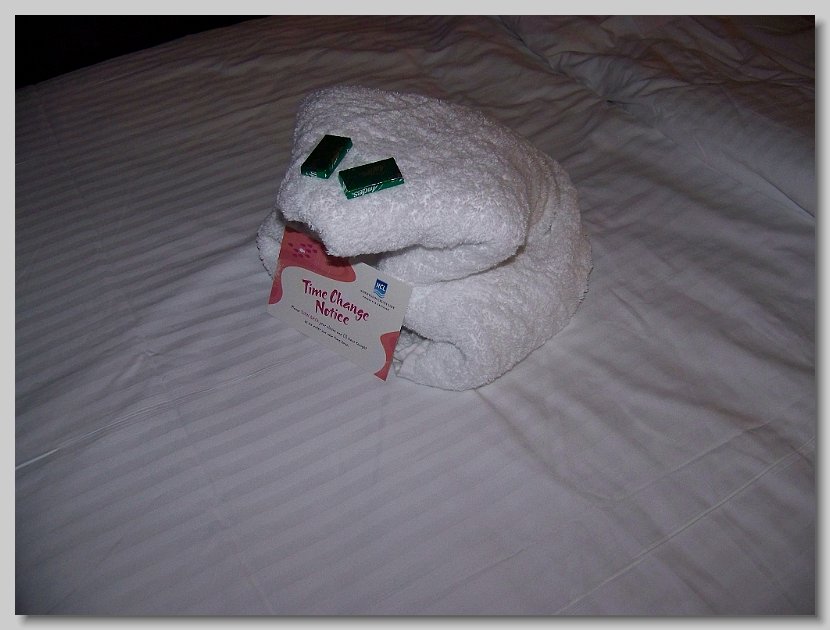 With a 4pm departure on Saturday, we spent most of the first two days just getting past Vancouver Island, headed for Ketchikan AK. The weather turned soggy on Sunday morning, but the day was pretty well filled with orientation gatherings and exploring the ship. Around 4:30 Monday morning, a visit to the bathroom revealed that our carpeting had also turned soggy. We quickly got dressed and opened our door to find three guys with shop vacs debating whether to violate our "Do Not Disturb" sign. Turned out a water pipe in the hall ceiling had ruptured, and most of the water had gone into the cabin next to ours. Unfortunately, some had gone into the wall between the cabins, and then into our room. As the ship was sold out, we couldn't get a different cabin, but they assured us it would take just a few hours to dry ours out. We headed down to the ship's library until breakfast time. By then, we were docking in Ketchikan. With a 4pm departure on Saturday, we spent most of the first two days just getting past Vancouver Island, headed for Ketchikan AK. The weather turned soggy on Sunday morning, but the day was pretty well filled with orientation gatherings and exploring the ship. Around 4:30 Monday morning, a visit to the bathroom revealed that our carpeting had also turned soggy. We quickly got dressed and opened our door to find three guys with shop vacs debating whether to violate our "Do Not Disturb" sign. Turned out a water pipe in the hall ceiling had ruptured, and most of the water had gone into the cabin next to ours. Unfortunately, some had gone into the wall between the cabins, and then into our room. As the ship was sold out, we couldn't get a different cabin, but they assured us it would take just a few hours to dry ours out. We headed down to the ship's library until breakfast time. By then, we were docking in Ketchikan.
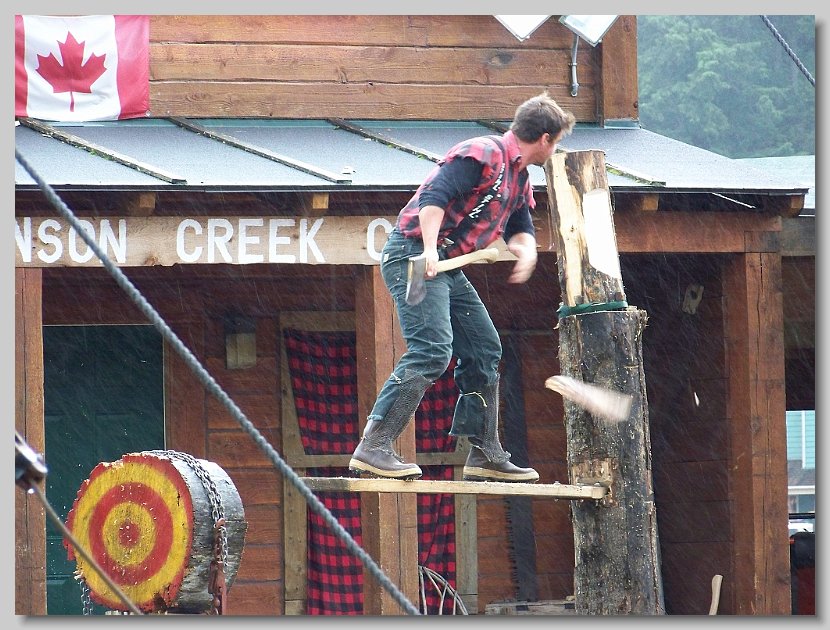 Our first port was Ketchikan, which calls itself "Alaska's First City". It was raining pretty hard by the time we headed down the gangway to wander a bit. The area where the cruise ships dock is pretty well touristed up, so we wandered through some of the shops and eventually found our way to Creek Street, the town's former red light district. It's all tourist shops these days, but the creek is still there and it was full of salmon and steelhead working their way upstream. We wandered back to the ship for lunch, found that our room was still soggy, and after lunch headed back into town for the Great Alaskan Lumberjack Show. Even though it was raining, the performers were energetic and enthusiastic. We learned, among other things, that many colleges offer lumberjacking as a sport; that there are collegiate lumberjacking tours; and that lumberjacking competitions are a big deal on some of the sports channels. Who knew? But it was great fun, and the show ended just in time for us to reboard the ship. On the way back upstairs to our cabin, we stopped to see if they'd found another cabin for us. No luck, so sorry, but we would like to give you a free dinner at Le Bistro, the premium French Restaurant. Worked for us. We made our reservations. Our first port was Ketchikan, which calls itself "Alaska's First City". It was raining pretty hard by the time we headed down the gangway to wander a bit. The area where the cruise ships dock is pretty well touristed up, so we wandered through some of the shops and eventually found our way to Creek Street, the town's former red light district. It's all tourist shops these days, but the creek is still there and it was full of salmon and steelhead working their way upstream. We wandered back to the ship for lunch, found that our room was still soggy, and after lunch headed back into town for the Great Alaskan Lumberjack Show. Even though it was raining, the performers were energetic and enthusiastic. We learned, among other things, that many colleges offer lumberjacking as a sport; that there are collegiate lumberjacking tours; and that lumberjacking competitions are a big deal on some of the sports channels. Who knew? But it was great fun, and the show ended just in time for us to reboard the ship. On the way back upstairs to our cabin, we stopped to see if they'd found another cabin for us. No luck, so sorry, but we would like to give you a free dinner at Le Bistro, the premium French Restaurant. Worked for us. We made our reservations.
 Juneau is Alaska's capitol, and it was our second port. We took it easy in Juneau - rode a shuttle from the ship to the heart of the tourist area, and then rode the tram up 188 ft to the top of Mount Roberts, where there were great views, a really nice gift shop (Judy bought a sweatshirt), a bird rescue center, and a most informative film about the Tlingit (pronounced "Cling-it") Indians. After a couple hours on the mountain, we rode back down and stopped in at a smoke house to see them smoking and canning fresh-caught salmon. Bought some to take home to Jan & Denny. Juneau is Alaska's capitol, and it was our second port. We took it easy in Juneau - rode a shuttle from the ship to the heart of the tourist area, and then rode the tram up 188 ft to the top of Mount Roberts, where there were great views, a really nice gift shop (Judy bought a sweatshirt), a bird rescue center, and a most informative film about the Tlingit (pronounced "Cling-it") Indians. After a couple hours on the mountain, we rode back down and stopped in at a smoke house to see them smoking and canning fresh-caught salmon. Bought some to take home to Jan & Denny.
After leaving Juneau, we sailed into the Tracy Arm Fjord, headed for Sawyer Glacier. Most people say the glaciers are the highlight of their cruise. We saw several glaciers as we spent four hours in the fjord, and lots of icebergs. We were told there are about 140 glaciers fed by the massive Juneau Ice Field, which covers about 1500 square miles. The ice can be up to a mile thick. Although we'd been told another cruise ship had made it to the base of Sawyer Glacier earlier that day, we didn't - they said there was too much floating ice in the 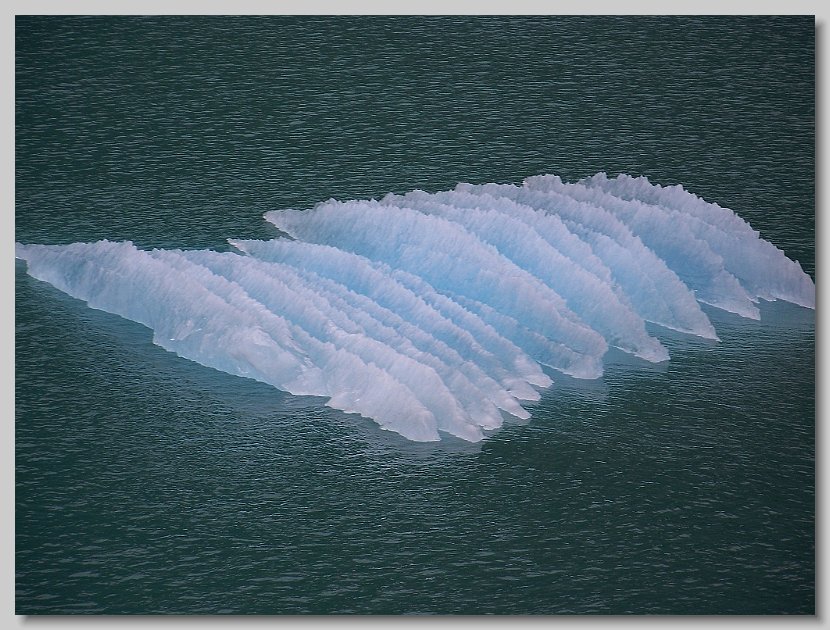 water. We did see some pretty big icebergs. This part of the cruise was why we bought a balcony cabin, and we spent most of the four hours outside. taking way too many pictures of icebergs, waterfalls and glaciers. About halfway through the approach to the glacier, there was a knock and a steward arrived with a bottle of champagne and a tray of chocolate-dipped strawberries "with our compliments". They must have figured a free dinner wasn't quite enough. water. We did see some pretty big icebergs. This part of the cruise was why we bought a balcony cabin, and we spent most of the four hours outside. taking way too many pictures of icebergs, waterfalls and glaciers. About halfway through the approach to the glacier, there was a knock and a steward arrived with a bottle of champagne and a tray of chocolate-dipped strawberries "with our compliments". They must have figured a free dinner wasn't quite enough.
That night, as we enjoyed our free dinner at the French restaurant, we were also surprised to learn it included complimentary wine. We perused the wine list as if we knew what we were doing and settled on about the only wine we drink - a Berringer White Zinfandel (under $7 at better discount grocers everywhere). We gotta learn to be upscale better.
 For us, the highlight of our trip was our visit to Skagway, the furthest north we sailed. Lots of people told us we had to ride the railroad in Skagway, so we booked an all-day bus-train excursion. Skagway's a small town - permanent population about 800. When the cruise ships come in, as many as 10,000 folks get off. Although the town was started as the jumping-off point for the Klondike gold rush, today it's tourist gold they're after. We got off the ship a little after 8am and were met at the gangway by an energetic young lady wearing a false mustache, hypnotic eye glasses and big plastic nose. She was "Cupcake", our bus driver/tour guide. We figured we were in for a fun day. For us, the highlight of our trip was our visit to Skagway, the furthest north we sailed. Lots of people told us we had to ride the railroad in Skagway, so we booked an all-day bus-train excursion. Skagway's a small town - permanent population about 800. When the cruise ships come in, as many as 10,000 folks get off. Although the town was started as the jumping-off point for the Klondike gold rush, today it's tourist gold they're after. We got off the ship a little after 8am and were met at the gangway by an energetic young lady wearing a false mustache, hypnotic eye glasses and big plastic nose. She was "Cupcake", our bus driver/tour guide. We figured we were in for a fun day.
Gold was discovered in the Klondike in 1896, and by 1898 the Alaskan Gold Rush was in full swing. Gold seekers arrived in Skagway from Seattle by the boatload. You can probably imagine what kind of town it was. Canada realized early on that these folks were ill-prepared for life in the Klondike, and decreed that nobody could cross the 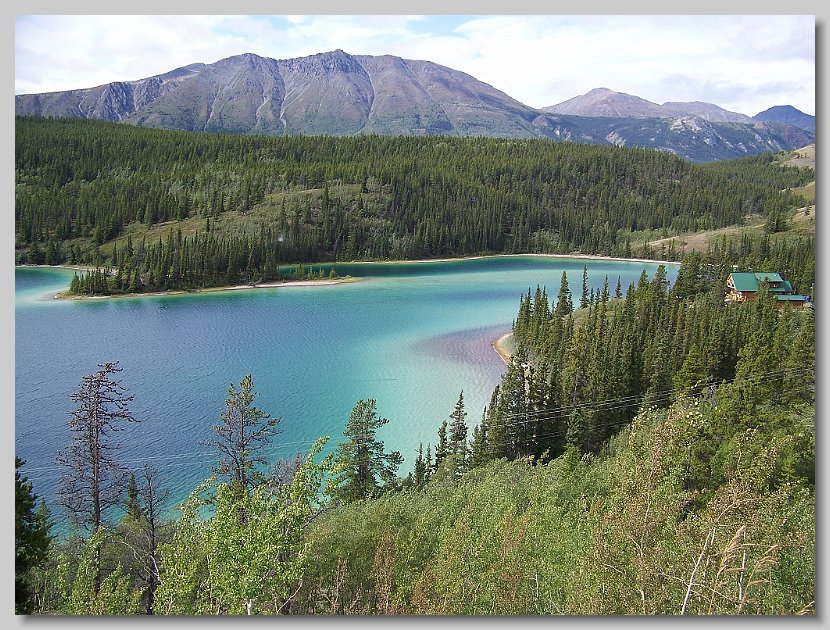 border without at least 2,000 pounds of supplies. The border was 20 miles up river (and up hill) from Skagway. There were no roads. The trail was strictly single-file, and the gold seekers had to get that ton of supplies up the trail to even get across the border. Most of them had no choice but to carry it on their backs - and make many many trips to get it all. Compounding the problem was that the trail was most passable in the winter, because then they could carve out steps around the rapids and waterfalls in the ice and snow. It's said the trail was so packed that if you got out of line for any reason (say a call of nature), it could take several hours before there was an opening to get back in. Those who could afford it bought pack horses and mules. But as there was no feed for the animals, most of them died along the way. They said you could smell the decomposing carcasses 15 miles downstream. It took most of the gold seekers several months to get all their supplies to the border. If they were lucky, nobody had stolen what they'd brought on earlier trips. border without at least 2,000 pounds of supplies. The border was 20 miles up river (and up hill) from Skagway. There were no roads. The trail was strictly single-file, and the gold seekers had to get that ton of supplies up the trail to even get across the border. Most of them had no choice but to carry it on their backs - and make many many trips to get it all. Compounding the problem was that the trail was most passable in the winter, because then they could carve out steps around the rapids and waterfalls in the ice and snow. It's said the trail was so packed that if you got out of line for any reason (say a call of nature), it could take several hours before there was an opening to get back in. Those who could afford it bought pack horses and mules. But as there was no feed for the animals, most of them died along the way. They said you could smell the decomposing carcasses 15 miles downstream. It took most of the gold seekers several months to get all their supplies to the border. If they were lucky, nobody had stolen what they'd brought on earlier trips.
That's when the idea of building a railroad was born. The White Pass and Yukon Railroad is a narrow-gauge line that runs from Skagway in Alaska to Whitehorse in the Yukon. It took just 26 months to build 110 miles of track, bridges, trestles and tunnels, and the project was completed in 1900. The railroad itself has been declared an International Historic Civil Engineering Landmark, along with things like the Panama Canal and the Eiffel Tower. Today it's Alaska's most popular cruise ship shore excursion.
 We rode our bus to several stops along the highway that now runs up the river gorge. We stopped for lunch at a place called Caribou Crossing, where they offer dog sled rides and a magnificent collection of stuffed and mounted animals. We visited the "world's smallest desert" and went through Canadian customs at least twice. But the highlight of the day was our 22 mile train mile ride downhill from Fraser Station YT to Skagway. We've ridden many "scenic" railroads, and this one is right at the top of the list. Words can't describe the views; you'll just have to look at our slideshow. One advantage of booking shore excursions through the cruise ship is they'll hold the ship for you if the excursion runs late. The train was about 20 minutes late, but the ship was still waiting when we finally got there. We rode our bus to several stops along the highway that now runs up the river gorge. We stopped for lunch at a place called Caribou Crossing, where they offer dog sled rides and a magnificent collection of stuffed and mounted animals. We visited the "world's smallest desert" and went through Canadian customs at least twice. But the highlight of the day was our 22 mile train mile ride downhill from Fraser Station YT to Skagway. We've ridden many "scenic" railroads, and this one is right at the top of the list. Words can't describe the views; you'll just have to look at our slideshow. One advantage of booking shore excursions through the cruise ship is they'll hold the ship for you if the excursion runs late. The train was about 20 minutes late, but the ship was still waiting when we finally got there.
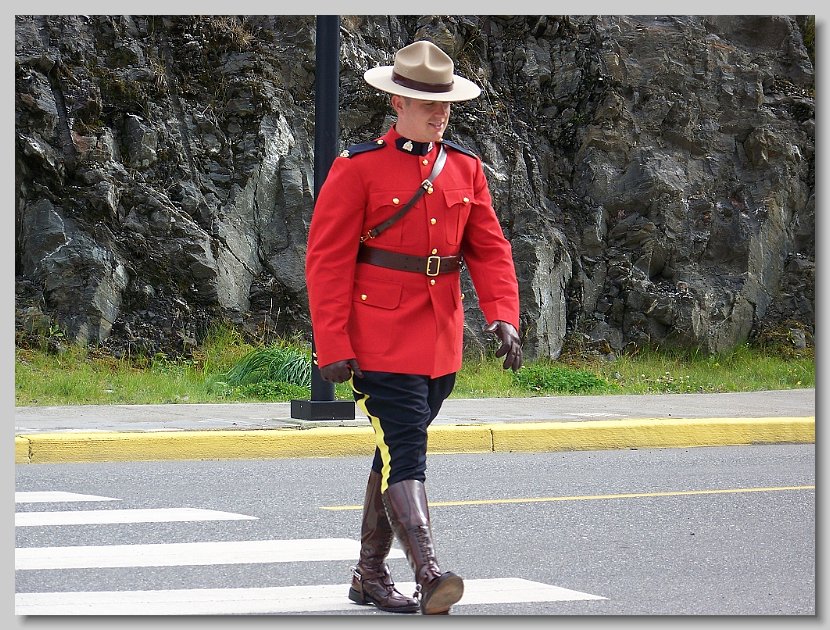 Our final port was Prince Rupert in British Columbia, a small town just beginning to try to exploit the cruise ship trade. The port area is delightful, the weather was warm and dry (for a change), and we enjoyed an afternoon stroll around town. Our final port was Prince Rupert in British Columbia, a small town just beginning to try to exploit the cruise ship trade. The port area is delightful, the weather was warm and dry (for a change), and we enjoyed an afternoon stroll around town.
We spent the final day of the cruise getting back to Seattle. As we were getting ready for dinner, came a knock on the door. A steward delivered a nice platter of fresh fruit and another bottle of champagne "with our compliments". As this was our third cruise aboard Norwgian Cruise Lines, we figure they're trying to keep us hooked. It's working . . .
We like to take cruises. If we shop well, it can be an affordable way to get a change of pace and visit places we'd not likely take our motorhome. We've learned that there are always deals available. Our two best sources of information are weekly free email newsletters from http://www.vacationstogo.com/ and http://top20.travelzoo.com/. And we've found that when we find something interesting on one of those two lists, we can almost always get a better price when we call the cruise line direct. Our "someday cruise list" currently contains the Panama Canal and the Mediterranean Sea, and the east coast of Mexico is starting to look interesting.
We started out with over 2,000 pictures taken during our Alaskan cruise. There are 130 survivors, and you can see them here.
|

 We've always wanted to take a cruise to Alaska, and this year an opportunity presented itself, so we did it. We sailed from Seattle aboard the Norwegian Star - the same ship we took for our Mexican cruise in February. We know that a cruise is just a taste of Alaska, but it's also a comfortable introduction to the kinds of things we could see and do if we spent some serious time in the state.
We've always wanted to take a cruise to Alaska, and this year an opportunity presented itself, so we did it. We sailed from Seattle aboard the Norwegian Star - the same ship we took for our Mexican cruise in February. We know that a cruise is just a taste of Alaska, but it's also a comfortable introduction to the kinds of things we could see and do if we spent some serious time in the state.